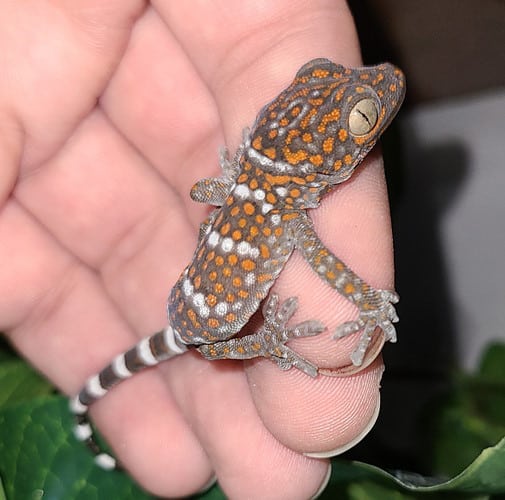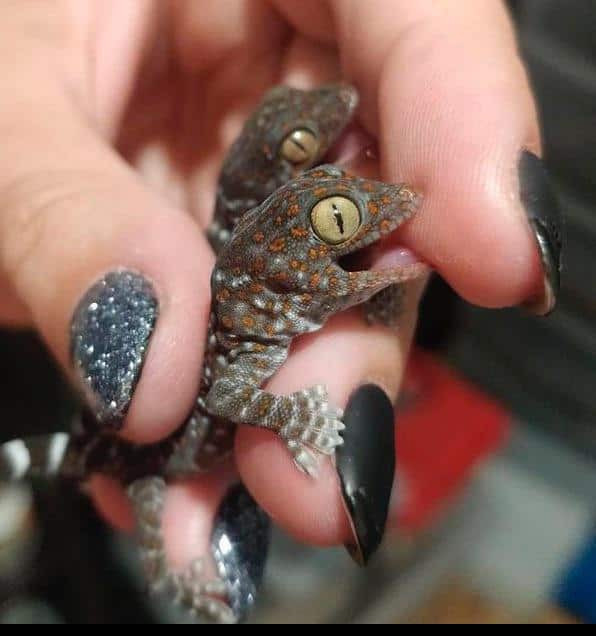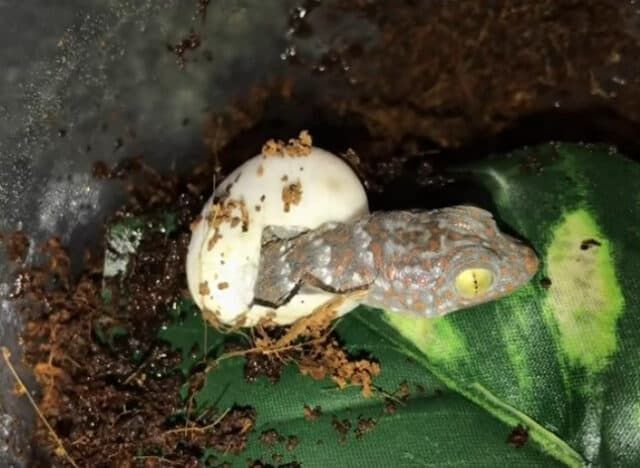Welcome, fellow reptile enthusiasts! In this journey of discovery and learning, we’re focusing today on the first 24 hours of one of nature’s most fascinating creatures, the Tokay Gecko. If you’ve found yourself here, chances are, you’ve either just become the proud parent of a newly hatched Tokay, or you’re preparing for this remarkable event. Either way, congratulations are in order!
This guide aims to provide you with the knowledge and tools necessary to navigate this critical period successfully. After all, the first day of a Tokay Gecko’s life is a crucial one, where the right care can lay the groundwork for a healthy and thriving future. So, buckle up and get ready for an incredible adventure, as we delve into the exciting world of caring for newly hatched Tokay Geckos!
Understanding Baby Tokay Geckos
Tokay Geckos, scientific name Gekko gecko, are among the largest and most vibrant geckos in the world. Native to Southeast Asia and some Pacific Islands, these nocturnal creatures are well-known for their stunning coloration and distinctive vocalizations, often mimicked as “To-kay, To-kay”.
As babies, they are tiny and incredibly delicate, requiring specialized care to ensure they grow into healthy, adult geckos. It’s important to remember that caring for a baby gecko is not simply a smaller-scale version of caring for an adult. The needs and vulnerabilities of hatchlings are unique, and understanding them is the first step to providing optimal care.
So, what’s so special about a baby Tokay Gecko? For starters, they are incredibly small, usually measuring just 3-4 inches in length at birth. They are born with a fragile and thin skin, which is sensitive to environmental conditions and susceptible to dehydration. At the same time, their tiny size makes them vulnerable to a host of potential hazards, from larger predatory insects to accidental injuries.
Despite these challenges, baby Tokays are also astonishingly resilient. They are born fully formed and are ready to start hunting and exploring their environment immediately. This blend of vulnerability and tenacity is a testament to the wonder of these creatures, and being part of their growth journey is truly a rewarding experience.
In the following sections, we will explore everything you need to know to care for a newly hatched Tokay, starting with understanding the hatching process itself, followed by setting up the perfect habitat, and finally, navigating the critical first 24 hours.
The Hatching Process of Tokay Geckos

Tokay Geckos, like many reptiles, are oviparous creatures, meaning they lay eggs from which the baby geckos hatch. This process is both fascinating and crucial to understand, as it will provide valuable insights into the care needs of your new hatchling.
Typically, female Tokays lay one or two eggs at a time. These eggs are somewhat unique in the gecko world, as they are hard-shelled rather than soft-shelled. They are affixed to a safe surface within the gecko’s environment and remain there until hatching, which usually occurs between 60 and 90 days later.
The moment of hatching is one of the most awe-inspiring sights in nature. The baby gecko uses a special, temporary tooth called an ‘egg tooth’ to break open the shell. Once the shell is pierced, the hatchling will slowly and painstakingly wriggle its way out. The process can take several hours, but it’s important to remember not to intervene unless absolutely necessary. The struggle to emerge from the egg is a vital part of the hatchling’s development, helping to strengthen its muscles and stimulate its system.
Once the hatchling has fully emerged, it may appear somewhat lethargic and will be coated in a thin layer of egg residue. This is completely normal. The hatchling will usually rest and recover from the hatching process before beginning to explore its surroundings.
Understanding the hatching process can help to prepare you for what to expect when your own Tokay eggs begin to hatch. However, it is also the beginning of a significant responsibility. The care provided in the first 24 hours post-hatch can greatly influence a Tokay’s health and survival.
Preparing for Arrival: Setting Up the Habitat
Before the hatching of your baby Tokay geckos, one of the most vital steps to ensure their safety and wellbeing is setting up an appropriate habitat. Given their small size and unique requirements, it’s crucial to create a safe, comfortable, and stimulating environment that meets all their needs.
Firstly, choose an appropriate enclosure. A small plastic container or a 10-gallon tank with a secure lid can serve well as a starter home for the hatchlings. Make sure the enclosure is escape-proof, as baby Tokays are notorious climbers and can easily find their way through tiny gaps.
The substrate forms the next layer of your habitat. Paper towels are a recommended choice for hatchlings due to their absorbency and ease of change, preventing the build-up of harmful bacteria.
Creating a conducive climate within the enclosure is paramount. Install a heat mat on one side of the enclosure to establish a temperature gradient, offering your hatchling a choice between warmer and cooler areas. Aim for a temperature range of 78-82°F (25-28°C) during the day and slightly cooler at night.
Humidity is another crucial aspect of the Tokay’s environment, helping them stay hydrated and aiding in shedding. Maintain a humidity level of about 60-80%, which can be achieved by misting the enclosure regularly.
Add some hiding places and climbing structures. These could be in the form of small plants, branches, or cork bark. Remember, the goal is to mimic their natural habitat as closely as possible, which means providing ample vertical climbing space.
Lastly, while Tokays are nocturnal and don’t require UVB lighting, a low-level UVB light can still be beneficial for them, supporting their overall wellbeing.
Remember, setting up the right habitat goes a long way in ensuring your baby gecko’s comfort and safety. After all, a well-prepared habitat will not only reduce the stress of the newly hatched gecko but also significantly simplify your care duties.
First 24 Hours: Critical Care Steps

The first 24 hours of a newly hatched Tokay Gecko’s life are some of the most critical. During this period, your care and attention can significantly influence the hatchling’s health and survival chances. Here, we’ll break down the key care aspects during these first vital hours.
Feeding: Despite their tiny size, baby Tokays come into the world ready to hunt and eat. However, their diet should consist of appropriately sized food to prevent choking. Suitable food items for a newborn Tokay Gecko include pinhead crickets, flightless fruit flies, and small mealworms. During the first 24 hours, you may notice your hatchling is not particularly interested in eating. This is normal as it adjusts to its new environment. Try offering food again after the first day.
Hydration: Proper hydration is absolutely crucial for a hatchling. While they receive some initial hydration from the egg, it’s essential to maintain this in their new environment. Regular misting of the enclosure with lukewarm, dechlorinated water will help keep the humidity levels appropriate and provide a source of drinking water. Baby Tokays will often lick water droplets from the enclosure’s walls or decor.
Temperature and Lighting: As previously mentioned when setting up the habitat, the temperature within the enclosure is vital. In the first 24 hours, make sure the temperature gradient is maintained, with the warmer end around 82°F (28°C). Although Tokays are nocturnal, providing a low-intensity UVB light can support their overall health and establish a day-night cycle.
Ensuring proper feeding, hydration, and temperature conditions for your newly hatched Tokay will set a strong foundation for its health.
Monitoring Health and Development
Observing and tracking your baby Tokay’s health and growth is a critical part of your caregiving role. Regular monitoring will allow you to catch any potential issues early and take appropriate action to rectify them.
The first thing to note is your hatchling’s activity levels. A healthy baby Tokay should be alert and active, particularly during the night. Look out for signs of healthy curiosity as your gecko explores its surroundings, climbs, and eventually, begins to hunt.
Weight gain and growth are other key indicators of a healthy gecko. Measure your hatchling’s weight and length every week. While growth may vary among individual geckos, any prolonged lack of weight gain or growth should be a cause for concern.
Your Tokay’s skin and eyes should also be regularly inspected. The skin should be smooth and hydrated, while the eyes should be clear and alert. Any signs of lethargy, dull skin, or cloudy eyes may signal health issues.
Another vital aspect to monitor is your baby Tokay’s feeding and defecation habits. Keep track of how much your gecko is eating and ensure it’s defecating regularly. A good appetite and regular defecation are positive signs of a healthy digestive system.
Remember, while it’s important to regularly monitor your gecko, it’s equally crucial to minimize stress during these checks. Handling should be limited, especially during the early stages of their life, as baby geckos are particularly sensitive to stress.
Common Problems and Solutions

While caring for a newly hatched Tokay Gecko can be an enriching experience, it’s not without potential hurdles. Awareness of common issues faced by baby geckos and how to address them can make your care journey smoother.
Dehydration: This is a common issue among hatchlings. Watch for signs like wrinkled skin, sunken eyes, and lack of activity. Increase the frequency of misting and ensure the enclosure’s humidity levels are correct.
Failure to Thrive: If your hatchling isn’t growing, isn’t active, or refuses to eat, it may be failing to thrive. This could be due to several factors, from stress to improper environmental conditions. Review your care routine and consult a reptile veterinarian if necessary.
Impaction: This occurs when a gecko ingests indigestible material, causing a blockage in its digestive tract. Always ensure food items are of appropriate size, and keep the enclosure clean to prevent accidental ingestion of substrate or feces.
Metabolic Bone Disease (MBD): Though less common in hatchlings, this disease is caused by calcium deficiency, leading to weak bones and deformities. Ensure a balanced diet and appropriate UVB lighting to prevent this condition.
Stress: Overhandling, loud noises, or frequent changes in the enclosure can stress your baby gecko. Keep handling to a minimum, maintain a quiet environment, and make gradual changes to the enclosure if needed.
Despite the potential for these issues, remember that many problems can be avoided through appropriate care and maintenance of your baby gecko’s habitat. Should you face challenges, know that you’re not alone. Reach out to experienced keepers or a reptile veterinarian for advice.
Conclusion
Caring for a newly hatched Tokay Gecko is a unique and rewarding journey, filled with discovery and wonder. Those first 24 hours mark the beginning of a beautiful relationship between you and your baby gecko. The care you provide during this critical period can set the stage for a healthy and thriving life for your new pet.
From understanding the hatching process to setting up the ideal habitat, from navigating the first day’s crucial care steps to regular health monitoring, each element plays a vital role in your hatchling’s wellbeing. Remember, challenges may arise, but with knowledge, patience, and love, you’re well-equipped to overcome them.
So here’s to you and your new Tokay Gecko, embarking on an incredible journey together. May the bond you form and the experiences you share enrich not only your pet’s life but yours as well.
FAQs
When will my Tokay Gecko start eating after hatching?
Baby Tokays are usually ready to start eating a day or two after hatching. However, it’s not uncommon for them to have a diminished appetite during the first few days as they adjust to their new environment.
How often should I feed my baby Tokay Gecko?
Newly hatched geckos should be fed daily. Offering a few small insects each day is usually sufficient. Remember to choose prey items that are appropriately sized for your hatchling to prevent choking.
Can I handle my baby Tokay Gecko?
It’s best to limit handling during the first few weeks. Baby Tokays are sensitive to stress, and overhandling can be stressful for them. When necessary, handle with gentle care, ensuring your hands are clean and warm.
When will my baby Tokay Gecko start to grow?
Growth rates can vary, but with proper care and diet, you should start seeing growth within a few weeks. Regular monitoring of their weight and length can help you keep track of their development.
What if my baby Tokay Gecko doesn’t seem to be thriving?
If your hatchling is consistently refusing food, losing weight, or showing signs of illness, it’s important to consult with a reptile veterinarian. Early intervention can often make a big difference in outcomes.
How long until my baby Tokay Gecko reaches adulthood?
With optimal care, a Tokay Gecko can reach its adult size of 10-15 inches in length by 1.5-2 years of age.